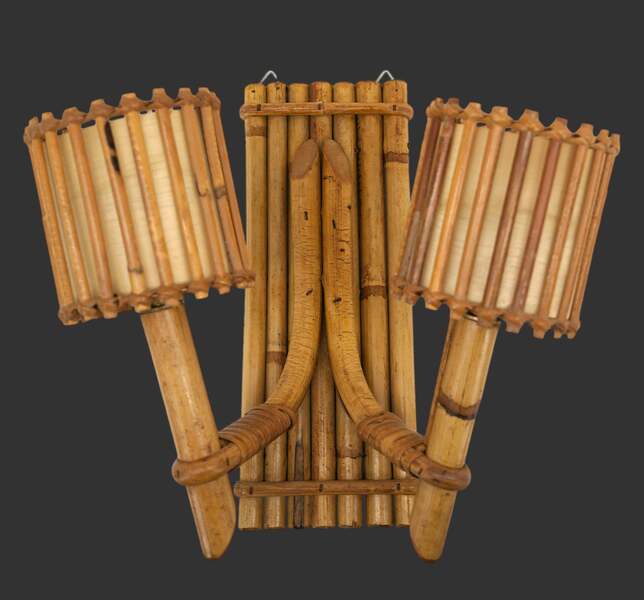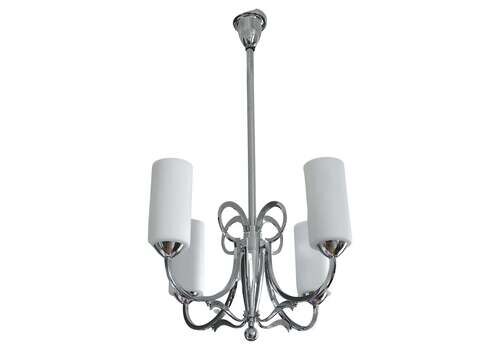Louis Sognot Double Bamboo Wall Sconce, 1950s
£1,469 per item
Shopping at Vinterior
-
14-day return guarantee
-
Outstanding customer service
-
Secure payment
-
Buyer protection
-
Trees planted for every purchase

Item details
Height
32.0 cm
Width
33.0 cm
Depth
21.0 cm
Wear conditions
Good
Wear conditions
Excellent
Shows little to no signs of wear and tear.
Good
May show slight traces of use in keeping with age. Most vintage and antique items fit into this condition.
Average
Likely to show signs of some light scratching and ageing but still remains in a fair condition.
Apparent Wear and Tear
Visible signs of previous use including scratches, chips or stains.
Please refer to condition report, images or make a seller enquiry for additional information.
Description
Double bamboo wall sconce by Louis SOGNOT, France, 1950s. Bamboo and paper. Paper shades. Height: 12.6"(32cm), Width : 13"(33cm), Depth : 8.3"(21cm). Very good condition. Delivered wired with B22 sockets for your country (US, UK, EU, China, Australia, etc). LED can be used.
Louis Sognot (1892-1970) is an artist decorator and designer. First of all protagonist of Cubism and the Modern Movement, he will distance himself from them by moving away from the radicalism of Functionalism to affirm a certain idea of comfort and quality; this unique position explains his dual involvement as a member of the Union of decorators, creators, interior designers (UADCE) and the Union of modern artists and, later, his commitment to the Institute of Industrial Aesthetics.
A former student of the École Bernard Palissy, he learned cabinetmaking with Jansen and then fitting out ocean liners in the Krieger workshop. After his demobilization in 1919, he entered the Grands Magasins du Printemps in 1920 to then managed the "Primavera" workshop after the death in 1931 of René Guilleré, alongside his wife Charlotte Chauchet-Guilleré, until the arrival of Colette Guéden in 1938. Primavera - which is one of the founding places of Art Deco - allows him to edit his first pieces of furniture which he presents from 1923 at the Salon d'Automne and at the Salon des artistes décorateurs. He thus invented an armchair in leather and flat chromed steel on springs in 1925, an enveloping chair in split leather and a strongly structured bar stool in chromed metal tubing, which he presented for Primavera at the Salon d'Automne in 1927 and which will be followed in 1929 by a more simplified black lacquered bar stool. The portfolio Répertoire du goût moderne N°5, published in 1929 by Albert Lévy, also includes a plate by Sognot from 1927 of a “Furniture in metal for a workshop-studio”.
The modern movement greatly inspired him and one quickly felt a strong influence of cubism in his creations, notably in the Primavera pavilion presented at the International Exhibition of Modern Decorative and Industrial Arts in 1925, where he also discovered the creations of Robert Mallet-Stevens and Francis Jourdain, who will largely influence his future achievements. Under their sponsorship, he joined the Union of Modern Artists in 1930, without however definitively breaking his ties with the Society of Decorative Artists.
Although influenced by chromed metal tube furniture as invented by Marcel Breuer, Louis Sognot would find his own marks in the Modern Movement from the end of the 1920s. From 1928 to 1933, he joined forces with Charlotte Alix by founding the Bureau international des arts français. They were the first to collaborate with the Société du Duralumin, a subsidiary of L' Aluminium Français, specializing in the manufacture of tubes and various profiles in aluminum alloys, which founded a workshop to assist architects and decorators in their projects. They then invent many sets in metal but which seek to escape the "Clinical Style" to reconcile with the quality of a certain French tradition claimed at the Salon des artistes décorateurs. In 1929, they had a tea room for a terrace in duralium created for the Printemps department stores, researched innovative materials, as much among metals, glass as plastics, and added to their furniture materials which, without being rare, give off a preciousness, such as mirrors, wood, rattan marrow, leather or colored fabrics6, which made them very widely noticed by the critics of the time, because they seemed to reconcile the productivism of industry and the individualism of decor:
“You can see that if they used metal almost everywhere, they only did so in a very rational way by making it part of the whole, by mixing it with wood without imposing it as the only material. They didn't look for standard formulas; on the contrary, they believe that each new piece of furniture has a new solution and this is how they have succeeded in giving intimacy to a material that some claimed was unusable for these purposes »
In 1930, at the first Salon of the Union des Artistes Modernes, to which they had joined from the outset, Louis Sognot and Charlotte Alix presented a "board room that could be transformed into a work room" intended for the development of the Roussel laboratories in Paris with furniture in square section metal tubing and glass which, with its metal armchairs upholstered in washable fabrics, is considered to be one of the most complete ensembles. At the Salon des artistes décorateurs of the same year, they presented a stand "Test of a rest room for a colonial dwelling" with the Duralumin Company, noticed by Maharajah Yeshwant Rao Holkar II and the Maharani of Indore who placed an order with them for the Manik Bagh palace, built and fitted out by the German architect Eckart Muthesius, including armchairs, a dressing table, a chaise longue and several other of their creations again exhibited at the 1931 Salon d'Automne and at that of the UAM of 1932 and adapted before being sent to India. Also in 1930, they produced an armchair and a swivel chair in black imitation leather and a chrome cruciform leg, and participated, along with Le Corbusier, Pierre Chareau, Francis Jourdain and a few other decorative artists, in fitting out the offices of the newspaper The Week in Paris, building built by Mallet-Stevens rue d'Assas.
Multiple technical research leads to experiences that effectively contribute to the evolution of modern furniture. At the 1932 Salon d'Automne, Sognot was a precursor by exhibiting a dining room in "lakarmé", a new plastic material, molded and lacquered, which enabled him to obtain light, incombustible furniture, in various shapes and futurists. The same year, they exhibited at the Salon de l'UAM a large rectangular dining room table cantilevered against a wall lined with a mirror with metal seats covered with rattan and an astonishing duralumin bed with pivoting bedside tables in glass slabs, which will be chosen in 1935 by the Maharajah of Indore. In 1933, they also invented furniture with tubular chrome zigzag legs, including magazine racks and bathroom stools.
Louis Sognot also fitted out, with Charlotte Alix and then without her, the studio of Jean Carlu, the bar of the Polo de Bagatelle, the offices of the Syndic of the city of Paris or even theater sets for Henri Bernstein.
He also designed boat cabin furniture in steel tubing, which won an award in the competition organized by the Technical Office for the Use of Steel and exhibited on his stand at the Salon d'Automne in 1934, then in 1935, the very functional rosewood and sycamore desk of the first doctor on board the Normandy liner. With Le Corbusier, Charlotte Perriand, Pierre Jeanneret and René Herbst, he also presented La Maison du Jeune Homme at the 1935 Universal Exhibition in Brussels.
A new turning point in his creation began with the International Exhibition of Arts and Techniques in 1937, when Louis Sognot was President of the group of window dressers at the Palais de la Publicité, when the first affordable quality creations were disseminated by middle classes - especially in the Swedish Pavilion. The baton was taken over at the Salon des arts de la maison in 1939 when he presented a very economical hotel room made entirely of rattan. The war interrupted this beginning of democratization but Louis Sognot resumed this work in 1945, designing models for disaster victims alongside René Gabriel19. He then resumed it with Jacques Dumond for standard apartments at the International Exhibition of Urban Planning and Housing in 1947.
During this period, he defined a precise creative vocabulary in which light wood, rattan - of which he became the specialist in France - and more occasionally metal intervened. It remains very dynamic until the 1960s, its luxurious creations are edited by Maurice Rinck (including the one presented at the Universal Exhibition of 1958) while other simpler models are produced industrially. Mixing one and the other in his stands, with household arts or decorative artists, and in his fittings, he creates particularly original associations where, in wide and flexible lines, contrast the light tone of the rattan, the bright colors of the fabrics and the black of the metal in the furniture, and in the lighting made in collaboration with Serge Mouille.
Louis Sognot is also a very recognized teacher who will train many creators. Patrick Favardin presents it as follows:
“He was an example and a reference for his students, by his talent, his know-how, and above all by a sensitive and full of finesse approach to his profession. His work as a decorator and designer is marked by a modernist spirit of remarkable openness."
He was :
Professor of decoration at the École Boulle, from 1926;
Professor at the Technical College of rue Duperré;
Professor at the School of Applied Arts in Industry from 1938;
Foreman at the National School of Decorative Arts, from 1947;
Artistic director at the Central Union School of Decorative Arts, from 1947.
Power Source: Hardwired
Lampshade: Included
Condition report:
EMPTY
Cancellations
We offer free cancellations and full refund for orders cancelled before dispatching. View full policy.
Returns
We have a 14-day return guarantee for orders from individual sellers, within the UK and European Union. View full policy.
Free collection available
Yes
Similar Wall Lights
Similar Wall Lights
More from this seller
More from this seller
Choose a Wishlist
Create Wishlist
- Ships from Saint-Amans-des-Cots, France
Cancellations and Returns
Last updated: 24th March 2025
We want everybody’s Vinterior experience to be seamless, so both buyers and sellers can fall in love with pre-loved. We designed our Terms of sale to treat everybody fairly.
However, sometimes things don’t go exactly to plan, and you may need to cancel or return an order.
To prevent this, we encourage you to check listings, photos and descriptions carefully before you buy. If you aren’t sure about a piece’s condition, size, provenance or shipping, just ask; click Contact seller to get in touch. Always contact your seller first if you have any queries, at any point in your purchase.
Our buyers receive the same protection when buying from all our sellers, both professional and verified.
Can I cancel an order?
There are many reasons why you might need to cancel an order, and you'll often be entitled to a refund. To cancel an order, click Create cancellation on the order page.
If you cancel your order before it has been dispatched, you will receive a full refund - including delivery costs. However, if your item has been shipped, delivery costs will not be included in your refund.
Please note: orders of bespoke, personalised or made-to-order pieces cannot be cancelled.
Can I return an order?
We understand that sometimes a piece isn’t the perfect fit. So if you no longer want your order, our returns process will ensure it finds a new home fast.
The Vinterior Guarantee included with your purchase entitles you to 14-day returns - allowing you to return any item within 14 days of the delivery date (except in specific circumstances, detailed below).
You can return your order if...
It isn't what you expected
If what arrives isn’t what you ordered, you can open a return. Just send us some photo evidence that the listing was inaccurate, misleading or misrepresented your purchased piece, and you’ll receive a refund.
You change your mind
If you don’t feel a piece is right for your space, you can return it. Once you request a change of mind return, you’ll be responsible for shipping the piece back to your seller as soon as possible. Delivery costs are non-refundable.
It's damaged in transit
In the rare event that an item arrives damaged or defective, you have a full 30 days from the date of delivery to return it for a full refund.
If your purchase arrives broken, always let us know. If Proovia delivered the piece, we can raise an insurance claim on the seller’s behalf. Or, the seller can raise a claim with their chosen courier.
What can't I return?
Just as there are some orders you can’t cancel, there are some you cant return, too. Personalised, bespoke or made-to-order pieces are non-returnable, and non-refundable. Sellers may also reject your return if the item has been altered in any way.
Please note: pieces on our site are pre-loved, not new. They may show some wear and tear; this is not sufficient grounds for a refund, unless the seller has misrepresented the item’s condition.
Lastly, neither Vinterior nor our sellers are liable for any damages or loss sustained in transit via third parties.
I'm eligible for a return. Now what?
To initiate a return, log into your Vinterior account, then go to the relevant order page and click Create a return. In the return request, be sure to include all the details: the reason for your return, an in-depth description, and photos of any issues or damage.
How will I receive my refund?
Once the seller confirms they’ve received the item (in the same condition it was sent), we will send your refund to your original payment method.
All items are inspected on return. If the seller receives the return with damage they don’t recognise, we will not be able to process your refund and the seller may need to send the piece back to you. You will be required to cover these delivery costs.










